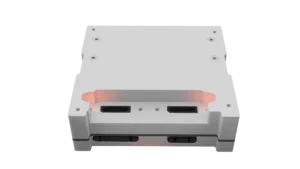A Belgian start-up says it has developed an on-board computing platform for satellites that can support 5G base stations and AI workloads in space.
 The company, EDGX has developed the Sterna computer – or Data Processing Unit – to provide in-orbit compute and AI processing capabilities.
The company, EDGX has developed the Sterna computer – or Data Processing Unit – to provide in-orbit compute and AI processing capabilities.
“We’re focussed on developing the world’s fastest edge compute service on board satellites,” says CEO Nick Destrycker. The device uses Nvidia’s Jetson Orin NX 16GB module, manufacturing it within specially designed hardware to withstand vibration, harsh thermal and vacuum conditions and radiation effects. EDGX also developed its own software operating system to enable on-board updating and software-defined operations, for example to be able to detect and recover from events such as particle radiation without a full reboot.
EDGX formed a development agreement with the European Space Agency in early 2024 to define an onboard neuromorphic, Data Processing Unit (DPU) tailored for satellite communication constellations in Low Earth Orbit (LEO).
It has a demo launch and flight planned for early 2026 on SpaceX’s Falcon 9, and says it has one large customer deal worth over EUR1 million and two smaller customers already – that’s unusual for a company with no space flight heritage, Destrycker adds.
The company has identified three key use cases for its edge compute device. One is to enable on-board AI processing for spectrum analysis and resource allocation. Another is earth observation and surveillance use cases, and the third is for satellite-based communications, including cellular NTN.
Wouter Benoot, co-founder and CTO, says that with the end use case of a regenerative gNodeB in space, you need to have processing autonomy on board the device.
“It’s impossible to for you to manage and operate everything from the ground and take care of all the data streams that are passing by, live on the spot. For example if you want a service that is really resilient against interference, as the spectrum is more and more crowded, then you have to move decision making on board.”
Benoot said that EDGX is seeing end customers interested in being able to do spectrum monitoring and intelligent radio resource allocation, but finding that the traditional space network infrastructure is not built to be open.
Cellular 5G NTN specifications are changing that, as is the concurrent drive towards developing RAN functions that work in containerised platforms. Then the push towards AI-RAN is also beneficial, with its concept of placing AI compute resources near to or at a cell site.
EDGX’s goal is to leave the lower PHY layer alone, but to run upper layer intelligence and processing on its DPU, with an integration between the two.
The driver for that new upper layer platform is that it is too difficult to engineer current FPGA-based systems to integrate well with AI.
“At the upper level layers, programming the entire stack in FPGA not a fun challenge. That’s where the DPU comes in, integrating high performance CPU and GPU AI core processing to alleviate those use cases and tie it into the infrastructure.”
“Our idea is to have a functional split on board where the lower level PHY layers are on FPGA processors and Sterna takes care of the upper layers where intelligence needs to happen. Because we are a fully Software Defined computer, we can play into third-party application software stacks as know that most satellite operators already have a preference for the type of software stack that they want to work with.”
Benoot says EDGX is already carrying out demonstrators with Open RAN software stacks, name-checking the likes of srsRAN, with that functional split running on the FPGA.
“Our goal is an in-orbit demo that ties AI use cases nicely into that computation stack, allocating resources go around interference, or processing earth observation to improve satellite services.”
EDGX recently closed a €2.3 million seed funding round co-led by the imec.istart future fund and, with participation from the Flanders Future Tech Fund, managed by the Flemish investment company PMV.
